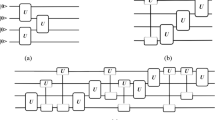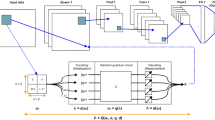Abstract
In this paper we propose two scale-inspired local feature extraction methods based on Quantum Convolutional Neural Network (QCNN) in the Tensorflow quantum framework for binary image classification. The image data is properly downscaled with Multi-scale Entanglement Renormalization Ansatz and Box-counting based fractal features before fed into the QCNN’s quantum circuits for state preparation, quantum convolution and quantum pooling. Quantum classifiers with one QCNN and two hybrid Quantum-classical QCNN models have been trained with a breast cancer dataset, and their performance are compared against that of a classic CNN. The results show that the proposed QCNN with the proposed feature extraction methods outperformed the classic CNN in terms of recognition accuracy. It is interesting to find that image bit-plane slicing has a similar internal mechanism to that of the Ising phase transition. This observation motivates us to explore the correlation between the chaotic nature of image and the classification performance enhancement by QCNN classifiers. It also implies that the pixels of the image and the Ising chaology particles share some similar patterns and are apt to classification.











Similar content being viewed by others
Explore related subjects
Discover the latest articles, news and stories from top researchers in related subjects.References
Biamonte J, Wittek P, Pancotti N (2017) Quantum machine learning. Nature 549(7671):195–202
Havlcek V, Crcoles AD (2019) Supervised learning with quantum-enhanced spaces. Nature 567(7747):209–212
Harrow AW, Montanaro A (2017) Quantum computational supremacy. Nature 549(7671):203–209
Beer K, Bondarenko D, Farrelly T (2020) Training deep quantum neural networks. Nat Commun 11(1):1–6
Tang E (2019) A quantum-inspired classical algorithm for recommendation systems. In: Proceedings of the 51st annual ACM SIGACT symposium on theory of computing, pp 217–228
Cong I, Choi S, Lukin MD (2019) Quantum convolutional neural networks. Nat Phys 15(12):1273–1278
Kossaifi J, Bulat A, Tzimiropoulos G (2019) T-net: parametrizing fully convolutional nets with a single high-order tensor. In: Proceedings of the IEEE/CVF conference on computer vision and pattern recognition, pp 7822–7831
Henderson M, Shakya S, Pradhan S (2020) Quanvolutional neural networks: powering image recognition with quantum circuits. Quant Mach Intell 2(1):1–9
Broughton M et al (2020) Tensorflow quantum: a software framework for quantum machine learning. Preprint arXiv:2003.02989
Bravyi S, Browne D, Calpin P (2019) Simulation of quantum circuits by low-rank stabilizer decompositions. Quantum 3:181
Farhi E, Goldstone J, Gutmann S (2014) A quantum approximate optimization algorithm. Preprint arXiv:1411.4028
Yang S, Wang M, Feng Z, Liu Z, Li R (2018) Deep sparse tensor filtering network for synthetic aperture radar images classification. IEEE Trans Neural Netw Learn Syst 29(8):3919–3924
Stoudenmire E, Schwab DJ (2016) Supervised learning with tensor networks. In: Advances in neural information processing systems, pp 4799–4807
Sun ZZ, Peng C, Liu D, Ran SJ, Su G (2020) Generative tensor network classification model for supervised machine learning. Phys Rev B 101(7):075135
http://tensornetwork.org/
Evenbly G, White SR (2016) Entanglement renormalization and wavelets. Phys Rev Lett 116(14):140403
Haegeman J, Swingle B, Walter M, Cotler J, Evenbly G (2018) Rigorous free-fermion entanglement renormalization from wavelet theory. Phys Rev X 8(1):011003
Evenbly G, Vidal G (2013) Quantum criticality with the multi-scale entanglement renormalization ansatz. In: Strongly correlated systems. Springer, Berlin, pp 99–130
Cincio L, Dziarmaga J, Rams MM (2008) Multiscale entanglement renormalization ansatz in two dimensions: quantum Ising model. Phys Rev Lett 100(24):240603
Panigrahy C, Seal A, Mahato NK (2020) Fractal dimension of synthesized and natural color images in lab space. Pattern Anal Appl 23(2):819–836
Panigrahy C, Seal A, Mahato NK (2021) A new technique for estimating fractal dimension of color images. In: Proceedings of international conference on frontiers in computing and systems. Springer, Singapore, pp 257–265
Panigrahy C, Seal A, Mahato NK (2019) Is box-height really a issue in differential box counting based fractal dimension? In: 2019 international conference on information technology (ICIT). IEEE, pp 376–381
Panigrahy C, Seal A, Mahato NK (2020) Image texture surface analysis using an improved differential box counting based fractal dimension. Powder Technol 364:276–299
Gavrilov A, Jordache A, Vasdani M, Deng J (2018) Convolutional neural networks: estimating relations in the ising model on overfitting. In: 2018 IEEE 17th international conference on cognitive informatics and cognitive computing. IEEE, pp 154–158
Kyle M, Isaac T (2018) Deep neural networks for direct, featureless learning through observation: the case of two-dimensional spin models. Phys Rev E 97(3):032119
Coyle B, Mills D, Danos V, Kashe E (2020) The Born supremacy: quantum advantage and training of an Ising Born machine. npj Quant Inf 6(1):1–11
Acknowledgements
The authors would like to acknowledge the financial support from National Key R &D Program of China (2019YFC0120102), Natural Science Foundation of Guangdong Province (Nos. 2018A0303130169, 2022A1515010485), National Natural Science Foundation of China (No. 61772140), the Special Projects in Key Fields of Universities in Guangdong Province (Nos. 2020ZDZX1023, 2021ZDZX1062), and the Opening Project of Guangdong Province Key Laboratory of Big Data Analysis and Processing at the Sun Yat-sen University(No. 201902).
Author information
Authors and Affiliations
Corresponding author
Additional information
Publisher's Note
Springer Nature remains neutral with regard to jurisdictional claims in published maps and institutional affiliations.
Rights and permissions
Springer Nature or its licensor holds exclusive rights to this article under a publishing agreement with the author(s) or other rightsholder(s); author self-archiving of the accepted manuscript version of this article is solely governed by the terms of such publishing agreement and applicable law.
About this article
Cite this article
Chen, G., Chen, Q., Long, S. et al. Quantum convolutional neural network for image classification. Pattern Anal Applic 26, 655–667 (2023). https://doi.org/10.1007/s10044-022-01113-z
Received:
Accepted:
Published:
Issue Date:
DOI: https://doi.org/10.1007/s10044-022-01113-z




